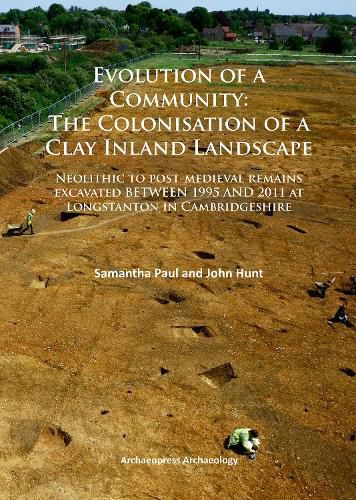Readings Newsletter
Become a Readings Member to make your shopping experience even easier.
Sign in or sign up for free!
You’re not far away from qualifying for FREE standard shipping within Australia
You’ve qualified for FREE standard shipping within Australia
The cart is loading…






The movement of people from the fen edge and river valleys into the clay lands of eastern England has become a growing area of research. The opportunity of studying such an environment and investigating the human activities that took place there became available 9 km to the north-west of Cambridge at the village of Longstanton. The archaeological excavations that took place over a sixteen year period have made a significant contribution to charting the emergence of a Cambridgeshire clayland settlement and its community over six millennia. Evolution of a Community chronologically documents the colonisation of this clay inland location and outlines how it was not an area on the periphery of activity, but part of a fully occupied landscape extending back into the Mesolithic period. Subsequent visits during the Late Neolithic became more focused when the locality appears to have been part of a religious landscape that included a possible barrow site and ritual pit deposits. The excavations indicate that the earliest permanent settlement at the site dates to the Late Bronze Age, with the subsequent Iron Age phases characterised as a small, modest and inward-looking community that endured into the Roman period with very little evidence for disjuncture during the transition. The significant discovery of a group of seventh-century Anglo-Saxon burials which produced rare evidence for infectious deceases is discussed within the context of ‘final phase’ cemeteries and the influence of visible prehistoric features within the local landscape. The excavation of the Late Anglo-Saxon and medieval rural settlement defined its origins and layout which, alongside the artefactual and archaeobotanical assemblages recovered creates a profile over time of the life and livelihood of this community that is firmly placed within its historical context.
$9.00 standard shipping within Australia
FREE standard shipping within Australia for orders over $100.00
Express & International shipping calculated at checkout
The movement of people from the fen edge and river valleys into the clay lands of eastern England has become a growing area of research. The opportunity of studying such an environment and investigating the human activities that took place there became available 9 km to the north-west of Cambridge at the village of Longstanton. The archaeological excavations that took place over a sixteen year period have made a significant contribution to charting the emergence of a Cambridgeshire clayland settlement and its community over six millennia. Evolution of a Community chronologically documents the colonisation of this clay inland location and outlines how it was not an area on the periphery of activity, but part of a fully occupied landscape extending back into the Mesolithic period. Subsequent visits during the Late Neolithic became more focused when the locality appears to have been part of a religious landscape that included a possible barrow site and ritual pit deposits. The excavations indicate that the earliest permanent settlement at the site dates to the Late Bronze Age, with the subsequent Iron Age phases characterised as a small, modest and inward-looking community that endured into the Roman period with very little evidence for disjuncture during the transition. The significant discovery of a group of seventh-century Anglo-Saxon burials which produced rare evidence for infectious deceases is discussed within the context of ‘final phase’ cemeteries and the influence of visible prehistoric features within the local landscape. The excavation of the Late Anglo-Saxon and medieval rural settlement defined its origins and layout which, alongside the artefactual and archaeobotanical assemblages recovered creates a profile over time of the life and livelihood of this community that is firmly placed within its historical context.